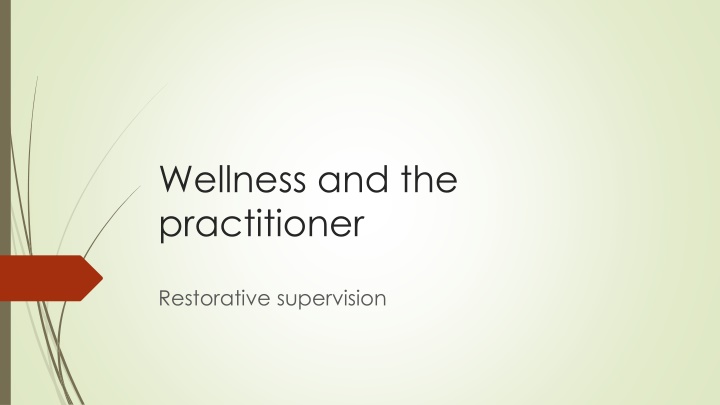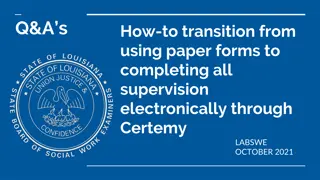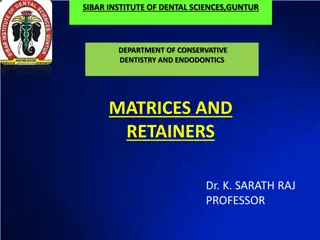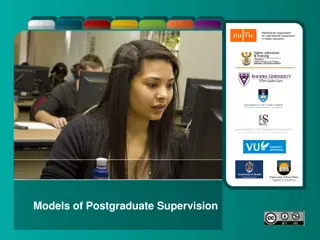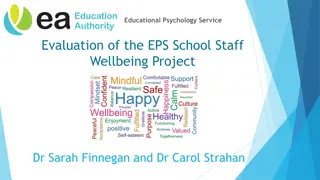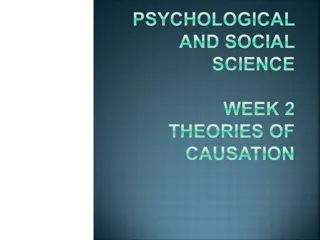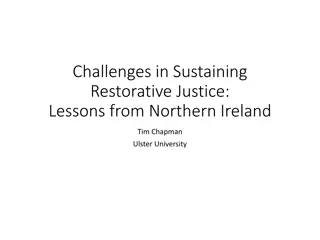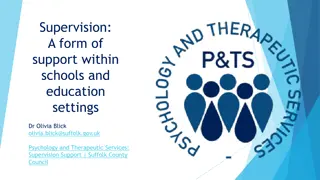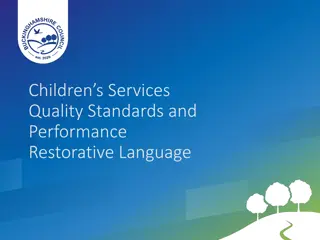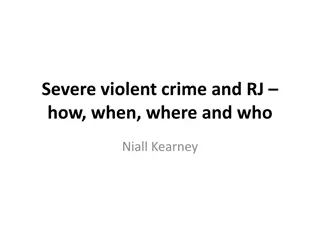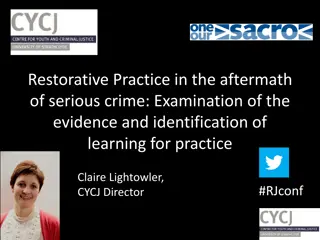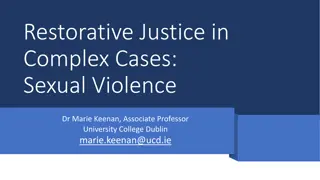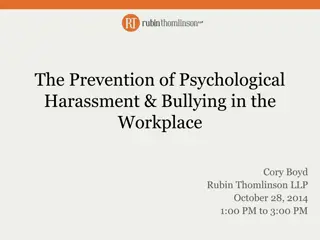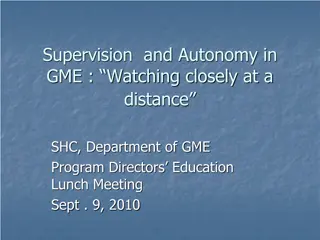Restorative Supervision and Psychological Wellbeing in the Workplace
This content delves into the importance of restorative supervision in addressing workplace stress, burnout, and psychological wellbeing. It explores the roles of supervisors and supervisees, strategies for engagement, and the impact of accumulated stress. Additionally, it discusses the modern stressors individuals face and the context of workplace stress in various professional fields, emphasizing the need for proactive measures to support mental health.
Download Presentation

Please find below an Image/Link to download the presentation.
The content on the website is provided AS IS for your information and personal use only. It may not be sold, licensed, or shared on other websites without obtaining consent from the author.If you encounter any issues during the download, it is possible that the publisher has removed the file from their server.
You are allowed to download the files provided on this website for personal or commercial use, subject to the condition that they are used lawfully. All files are the property of their respective owners.
The content on the website is provided AS IS for your information and personal use only. It may not be sold, licensed, or shared on other websites without obtaining consent from the author.
E N D
Presentation Transcript
Wellness and the practitioner Restorative supervision
What we will cover today Psychological wellbeing at work Stress Burnout Restorative Supervision: a definition and characteristics Supervisor Role Supervisee Role Unconscious Behaviours Conclusions
Psychological wellbeing Definition Concerns emotions associated with: Knowledge & skills Feeling self determination Feeling valued Support and validation (Milne & Reiser, 2020)
If the goal within supervision is engagement: What can we do in supervision that can engage people instead of deplete them?
Accumulated Stress & Burnout Deceptive stresses that can accumulate over long periods of time and become debilitating
Stress is the modern world Many people experience worry, sleep problems and fatigue that affects performance at work Even the lesser symptoms can lead to more serious mental health conditions Remember that stress is cumulative In a post covid world stress, anxiety and depression are likely to increase in the community and at work Stress is an interaction between a person and their environment (Folkman & Lazarus, 1984)
Activity in Pairs How does stress show up in your life even if you are not always aware of it Feedback to the group
Workplace Stress: The context Resource constraints, targets (KPIs), budgets High risk carried with greater accountability - managerialism The public and media Professional cultures going above and beyond Workplace exposure to verbal and physical abuse in health and social care (Hunt et al., 2015) Traumatic events and social context: Christchurch earthquakes, eruption of Whakaari/White Island; 2019 Mosque massacre; Covid, Housing, Child Poverty, Mental Health
Workplace stress continued: Work Related Trauma - A sudden and massive attack on personal safety and or identity and integrity Transference Counter transference The practitioner projects their own unresolved conflicts onto their client Vicarious Traumatisation (VT).- Empathetic engagement with traumatised clients or their experience of trauma. Compassion Fatigue (CF)- Distress experienced by the supervisee
Individual vulnerability factors Level of commitment Job security Unclear or conflicted expectations Hostile or defensive atmosphere in the workplace Unethical environment Lack of communication mixed messaging Isolation
Activity in Pairs How does stress show up in your work life even if you are not always aware of it? Feedback to the group
Predictors of workplace stress and anxiety Category 1: high workload, unrealistic time pressures, low job control and minimal decision-making ability Work overload, lack of control and role ambiguity are predictors of stress at work (Gyllensten et al., 2005) Category 2: Occupational uncertainty, organisational change, perceptions of job and financial insecurity Category 3:). Lack of respect from negative workplace experiences including organisational change, conflict or bullying. (Harvey, et al., 2017)
What Happens? Workers feel powerless; Clients can be ungrateful or even hostile, Workers feel drained and have nothing left to give, Workers become reactive, And therefore; Workers are going through the motions. Don t reflect, Often this results in collusion of colleagues, teams and organisations
Burnout Burnout: . a syndrome of emotional exhaustion, depersonalisation and reduced personal accomplishment that can occur among individuals who do people work of some kind. (Maslach & Jackson, 1981 p. 99) Burnout is a contentious term: Maslach & Leiter, (2017) argue that burnout is distinct from depression Burnout and depression can both be the result of unresolved job stress or tensions outside work that affect job performance (Bianchi, et al., 2016)
High Burnout rates in the helping professions Lack of leadership/management High workloads Working in isolation Chronic fear of change/redundancy Lack of professional recognition Office and interagency politics Feeling undervalued Personal risk
Symptoms of burnout Psychological symptoms: emotional exhaustion, loss of self-belief, loss of confidence, ruminating thoughts leading to suicidal thoughts or actions Behavioural symptoms: aggression or withdrawal and negative coping behaviours such as heavy drinking or drug abuse, with severe mental health outcomes, Physical symptoms: heart disease, thyroid problems and high blood pressure (Palmer et al., 2003)
Activity in Pairs List one self-care strategy that helps you at work List one self-care strategy that helps you at home Name a self-care strategy you would like to start but can t commit to and why Feedback to the group
How does Supervision help Supervision supports professional resilience (Adamson, et al., 2014) Supervision supports professional identity (Harvey, et.al., 2017) There is a strong link between a positive professional identify and resilience Professional supervision can act as a buffer between negative experiences and a negative or unhealthy response to experiences (Davys & Beddoe, 2020) Professional supervision is an extra resource that can be provided by organisations to support individuals and create healthier workplaces
Effective restorative supervision Supervision Relationship Supervision Contract: negotiating the process, expectations, professional needs Experiential learning : reflection Supervision is linked to practice and is person centered Constructive Feedback and Validation Personal coping strategies, self care plan, regular self care checks Regular uninterrupted sessions in a quiet space Support
Group Work Discuss in your pair/triad, thinking about the warmup exercise about your past experiences of supervision, how did your supervisors demonstrate those elements?
Supervision Vs. Therapy Superficially supervision and therapy may appear to be the same thing, and it is easy for the two to become confused. The simple answer is to maintain boundaries . But maintaining boundaries is difficult without clarity of what those boundaries are. (Krouwell, 2018)
Similarities Collaboration process goal orientated Both practices require a degree of rapport in the exchange of information Confidentiality Reflective space Theoretical underpinning i.e., solution focused, CBT, Rogerian approaches
Differences Outcomes therapy aims to resolve a problem which exists for the person whereas supervision seeks to improve the quality of practice Therapy is about repair; supervision is about enhancement Therapy is actively seeking mental health; supervision acts as a preventative against the decline in mental health
The responsibility of the Supervisor To ensure restorative supervision Providing a reflective space in supervision Providing opportunities for debriefing .e.g., following critical incidents To contain emotion but provide a safe space to release emotion Acknowledging the impact of personal life and crises on work Exploring the affect of conflict on performance and mental health Developing self -awareness Identifying transference and counter transference Recognising the signs of stress, overload, exhaustion, compassion fatigue and burnout Identifying and challenging unhelpful coping strategies and unhelpful patterns of thinking or behaviour
Supervisor Role Be knowledgeable about supervision Build a strong supervision relationship Ensure there is a clear supervision contract Facilitate reflection Make supervision a supervisee led process Provide opportunity to give and receive feedback Ensure self-care is a rolling agenda item Provide self care frameworks and strategies Recognise signs of stress, burnout, overload, compassion fatigue
Restorative interventions Active listening Therapeutic skills minimal encourages and questioning techniques Create a safe place Reflective learning opportunities Support the worker with the emotional demands of their work Encourage collaboration and managing professional relationships Move forward rather than remain stuck Encourage collaborative decision making Advocacy if needed (Davys & Beddoe, 2020)
Facilitative forms of intervention Cathartic Allows the worker to express their emotions and share their frustrations Catalytic Allows the worker to learn from themselves by offering a way to reflect on themselves and their actions Supportive Allows the worker to develop a good feeling about themselves and to strengthen trust and self-confidence
Restorative Model - PERMA Five Dimensions: P Positive Emotion What makes you happy E Engagement What are you engaged in R - Relationships Ways to reach out to support networks M -Meaning Where do you find meaning in life A Accomplishments What are the things that make you feel a sense of accomplishment (Madeson, 2017)
Supervisee Role Be ready for your work fit and well and the right attitude Be self aware appraise situations, emotional processing Develop personal coping mechanisms Reflection Contemplation (mindfulness) Ensure physical and motivation for supervision (Davys, 2022)
Active participant in Supervision Value the supervision process prepare for and be knowledgeable about supervision Attend to the relationship know what you want/expect and be willing to contribute Negotiate a contract and articulate needs Be present in supervision and open, honest, responsive Be open to feedback give feedback Self care make it an agenda item, strategies Take responsibility to address difficulties relationships, policy, practice
What does the research say: We found supervision, as provided by managers, was often focused on case management processes, such as targets and timescales, at the expense of critical reflection and emotional support (Beddoe et al., 2021) Despite managers perceptions that essential components of quality supervision were child focused, reflective, supportive, and analytical, the analysis showed that sessions did not proceed as planned and became primarily managerial oversight (Wilkins et al., 2017)
Unconscious Processes in supervision Why are supervisees and supervisors recruited, captured, drawn into and enticed into challenging processes? We are human!!!!!! May have lost focus, feel overwhelmed, anxious or out of our depth Our role and boundaries get blurred Fear of victimization, conflict, complaint etc. Stress, burnout, overworked Unresolved personal issues, feelings
Compassion Compassion both requires and cultivates self-kindness, empathy, a sense of common humanity, loving kindness, curiosity and non-judgementalism The supervision relationship is an opportunity to grow ourselves a compassionate heart that serves our clients in a way that is also sustainable for us (Nickson, 2019, pg. 195)
Compassion and Empathy Empathy is our feeling of awareness toward other people s emotions and an attempt to understand how they feel, I understand what you are going through. I have been there Compassion is when you relate to someone s situation and want to help them, I can understand your distress and I want to help
Compassion Fatigue Compassion fatigue is a term that describes the physical, emotional and psychological impact of helping others often through experiences of stress or trauma. Compassion fatigue is often mistaken for burnout, which is a cumulative sense of fatigue or dissatisfaction. The difference between burnout and compassion fatigue is burnout is more physical exhaustion and compassion fatigue is emotional Signs sadness and grief, nightmares, sick days Symptoms Poor concentration and judgment, headaches, digestive problems, relationship difficulties Triggers Prolonged exposure to trauma material of clients
Transference Transference is when the client or/and supervisee is affected by material from another relationship (usually from the past) and this material is brought into and colours a current interaction.
Counter-transference Is when it is the helper (worker or supervisor) who is affected by material from another relationship (usually from the past) and this material is brought into and colours a current interaction. In dealing with Transference / Counter-transference useful questions to ask are: Who does this person remind me/you of? How is this reminder of affecting my/your client/practitioner/supervisor (Schamess, 2006)
Drama Triangle Rescuer Responsibility Persecutor - Power Victim - Vulnerability
Useful reminders 1. While supervision may open-up personal aspects, as supervisor always metaphorically keep one of your feet connected to their work focus. 2. Always have as your aim, their growth as a professional rather than personal change/growth for its own sake. 3. Remember to link to an educative role. What learnings /connections can be made to their work. 4. Be clear about the boundary between counselling and supervision
References Adamson, C., Beddoe, L., & Davys, A. (2014). Building resilient practitioners: Definitions and practitioner understandings. British Journal of Social Work, 44(3), 522-541. Davys & Beddoe (2020) Best practice in professional supervision. (2nd ed.). Jessica Kingsley. Folkman, S. & Lazarus, R. S., (1984). Stress, appraisal, and coping Springer publishing company. Gyllensten, K., Palmer, S., & Farrants, J. (2005). Perceptions of stress and stress interventions in finance organizations: Overcoming resistance towards counselling. Counselling Psychology Quarterly, 18(1), 19-29.
References cont. Harvey, S. B., Modini, M., Joyce, S., Milligan-Saville, J. S., Tan, L., Mykletun, A., & Mitchell, P. B. (2017). Can work make you mentally ill? A systematic meta- review of work-related risk factors for common mental health problems. Occupational and environmental medicine, 74(4), 301-310. Maslach, C., & Leiter, M. P. (2017). New insights into burnout and health care: Strategies for improving civility and alleviating burnout. Medical teacher, 39(2), 160-163. Maslach, C., & Jackson, S. E. (1981). The measurement of experienced burnout. Journal of organizational behavior, 2(2), 99-113. Palmer, S., Cooper, C. L., & Thomas, K. (2003). Creating a balance: Managing stress. British Library Board.
